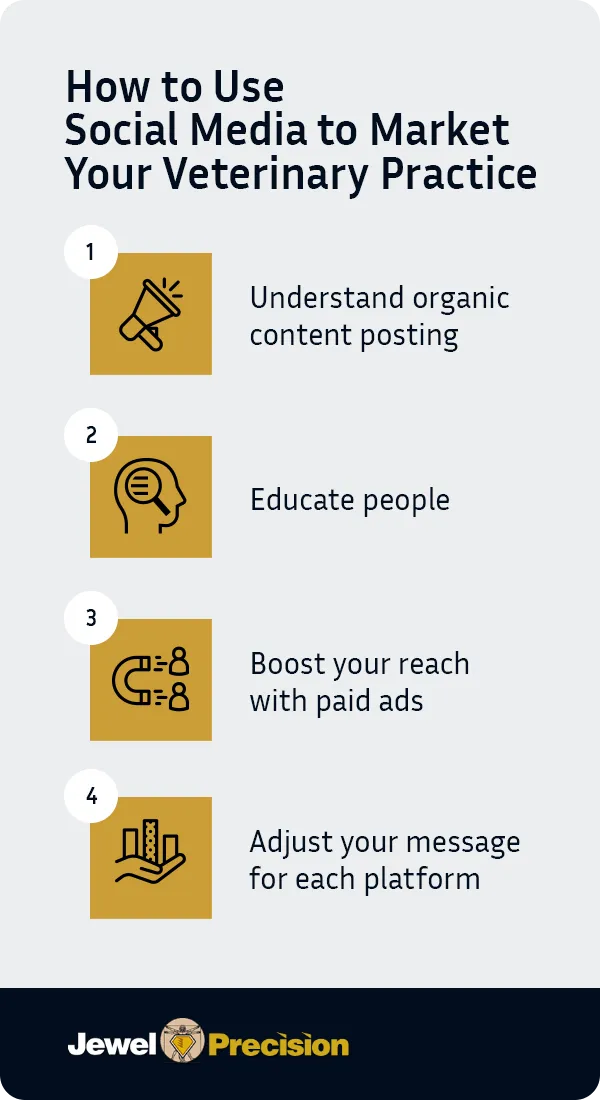
A staggering 86.9 million United States households have a pet, and veterinary service revenue will continue to rise in 2024. As a veterinary practice, you have a unique opportunity to capitalize on this growth, provided you can encourage pet owners to visit your practice. Knowing how to market a veterinary clinic is becoming more critical. With increased advertising opportunities in the digital space, creative veterinary marketing ideas are essential to set your practice apart.
The Benefits of Robust Veterinary Marketing Tactics
With more than 120,000 vets in the U.S., veterinary marketing is essential, whether you’re launching a new practice or expanding your current one to attract new clients. Effective marketing can bring in new patients and cement your relationships with your current patients, boosting your reach and engaging new and existing customers.
Competition is fierce in the companion animal industry, and creative marketing ideas for veterinary clinics can differentiate you from competitors, keeping your brand visible and boosting trust. Some of the many benefits of effective vet office marketing include:
- Growing your clinic.
- Reaching a larger pool of potential clients.
- Increasing your earnings and gaining a positive return on investment for your marketing.
- Retaining your current customer base.
In today’s digital age, you risk losing customers if other practices are more visible across multiple channels. Investing in a comprehensive veterinary marketing strategy sets you apart from other vets in your area. It allows customers to be part of your story.
Veterinary Marketing Strategies
Before you consider how much your veterinary clinic should put toward marketing, it’s best to know your available avenues so you can tailor your message to your audience and work within your budget. You can categorize all marketing activities into two groups.
Digital Marketing
Digital marketing involves promoting your veterinary practice through the internet and other digital tools. As technology has evolved, businesses have gained access to quick, efficient and effective digital marketing options. As 47% of global purchases are completed online, an online marketing presence is a powerful way to boost your reach.

One of the benefits of digital marketing is that you’re more likely to reach the right audiences. You can also access vast amounts of data to inform your future strategy. Some common forms of veterinary online marketing include:
- Social Media
- Email Marketing
- Digital Ads
- Search engine optimization (SEO) and local SEO
Traditional Marketing
For many businesses, including veterinarians, digital marketing seems the obvious choice. Although it offers significant benefits, don’t discount traditional marketing strategies for veterinary clinics, including:
- Radio advertising
- Print advertising
- Mailers
Combining digital and traditional marketing is the most effective way to broaden your reach and create a cohesive brand experience. The two channels can work together to attract the right audience. For example, a potential customer might come across one of your flyers and use the content to visit your website and social media. This journey from traditional to digital builds trust and increases the number of impressions — or times when someone sees your brand.
Developing a sound veterinary marketing strategy involves integrating traditional options with digital tactics to give your customers a personalized experience. The primary consideration is which methods to combine to yield the best results.
Social Media for Veterinarians
Social media is a popular tool for small animal vet practices. A massive 4.9 billion people worldwide use social media, and the average person spends 145 minutes on social media platforms daily. People love animal posts and use them to connect with other pet lovers. As 35% of worldwide cat and dog owners have social media accounts for their pets, your practice can reap significant benefits with a simple veterinary social media calendar.
The most attractive things about social media are its cost-effectiveness and reach. You can choose from several platforms, each targeting a different niche within your broader audience. Some popular social media platforms include:
- Facebook: Facebook remains the most popular social media platform, with 2.9 million active monthly users. Veterinary Facebook posts are an excellent way to educate and connect with your audience, broaden your reach, build trust, and keep your brand at the forefront of their minds.
- Instagram: While Instagram targets a younger audience of pet owners, it’s an excellent platform for sharing pictures and short videos.
- YouTube: A veterinary YouTube channel is ideal for educating and entertaining. People often turn to YouTube for “how to” content, like clipping their dog’s nails. You can use videos to illustrate your expertise and give your audience a behind-the-scenes look at how your practice works.
- TikTok: TikTok allows users to create, watch and share short videos. Many users turn to the platform for entertainment, making it the ideal platform to appeal to a younger demographic and show off the funnier side of your veterinary practice.
How to Use Social Media to Market Your Veterinary Practice
Developing veterinarian social media post ideas is only part of your overall strategy. Social media can help you reach the right audiences, but following a sound strategy and best practices will get the best results from each platform. Some tips and tricks to boost your social media success include:
- Understand organic content posting: Organic social media posts are those you share without spending money to boost their reach. It might take longer to build an organic following. Still, in doing so, you establish your practice as a trusted resource, increasing the likelihood that people will contact you when they need assistance. The key to successful organic posts is high-quality content. Keep your posts engaging and authentic, and you’ll start to build a following.
- Educate people: Many social media users use their favorite platform to learn about a specific topic. Pet owners want to know the best ways to care for their beloved animals. Educational posts allow you to help and support your audience.
- Boost your reach with paid ads: Running ads on social media platforms is a cost-effective way to boost your reach. Social media ads allow you to define your audience and optimize your budget. Delivering targeted messages to the right people results in higher conversion rates and better returns on your marketing efforts. You can also track the results of your paid ads in real time and adjust to leverage what works and remove what doesn’t.
- Adjust your message for each platform: While you can often keep the same topic for different social media platforms, knowing your audience is essential. Make minor adjustments to keep your posts appealing.

SEO and Local SEO for Vet Offices
Over 90% of worldwide searches start on Google, and less than 1% of users reach the second page of search results. Search engine optimization (SEO) can get you on that first page. SEO focuses on keywords your target audience will likely input into a search engine and directs unpaid traffic to your website when they search for these words and phrases.
SEO makes your website the central hub of your marketing. First impressions are critical, as people form opinions about a website in 0.05 seconds. Your website should be visually appealing and easy to navigate. Put yourself in your audience’s position and create a seamless user experience on your website, including publishing helpful content with concise headlines, attention-grabbing language and exciting visuals.
Local SEO involves targeting people searching for services in a specific area with keywords like “veterinarian near me.” As a veterinary practice, you’re often limited by geography, so optimizing your website for local search results makes sense. Combining local and organic SEO, you can maximize your visibility while reaching more clients in your area.
Market Your Veterinary Practice With a Blog
Blogging improves your SEO quality by positioning your website as a relevant answer to users’ questions. For example, if a user types a question about pet skin allergies into a search engine and you’ve crafted engaging content that answers that question, the user is more likely to end up on your website searching for an answer.
Leverage Conversion Rate Optimization (CRO)
Conversation rate optimization (CRO) involves increasing the percentage of users who perform a desired action on your website, from making an appointment to clicking on a link. It’s another powerful tool in marketing your veterinary practice, getting you more from your existing traffic. Much of CRO is visual, drawing users’ eyes to the form or button you want them to click. Some basic CRO best practices include:
- Use strong colors: Vivid colors attract the eye. Use them for call-to-action (CTA) buttons and any other elements you want to highlight on your website.
- Create a sense of urgency: Consider how to encourage visitors to engage with your website in real time, like creating limited-time offers or offering perks for filling out a form.
- Focus on clarity: Be clear about what you offer and the action you want your visitors to take.
- Keep your CTA above the fold: Anything above the fold is visible to users before scrolling. Ensure users can convert before they scroll to avoid missed opportunities.
Create a Google Business Profile
Google Business Profiles are free and get priority on the first page of local search results. The setup is quick and easy, and with a few additional steps, you can leverage the platform to attract local customers. Consider the following best practices:
- Write a flawless description: Keep your description professional and try to make it as local as possible. Include up to three relevant keywords to describe your practice.
- Add posts: You can write and publish posts on your Google Business Profile to increase user interest. Add a CTA and highlight your special offers with additional content.
- Include photos: Add photos to your profile to draw users’ attention. Post often to show Google that the profile is active.
- Collect and respond to reviews: Reviews are critical to rank in a local search. Ask your existing clients to leave reviews on your profile. Respond to them all, positive or negative, showing people you’re committed to customer service and correcting your mistakes.
Digital Ads for Veterinary Practices
The average American is exposed to between 4,000 and 10,000 ads daily, making them an excellent choice for your vet office marketing. Running pay-per-click (PPC) ads on Google and Bing is a cost-effective way to attract new clients. PPC is a strategy in which you pay to have your practice appear toward the top of search engine results when people search for specific services. When someone clicks on your ad, they are transported to your website, and you pay a small fee.
Users can choose to focus on organic results, but featuring images of pets and targeting a specific service, such as vaccinations or sterilizations, can improve your website’s rankings.
Email Marketing for Veterinarians
Marketing for veterinary practices is as much about engaging with your current clients as attracting new ones. You can only communicate with people who have agreed to receive your email. Still, it remains a cost-effective way of educating, selling and building a community. A well-thought-out email keeps you at the forefront of people’s minds, especially if it includes promotional offers only available to subscribers. Depending on your goals, you can launch several email marketing campaigns, including:
- Promotions: Send subscribers a short message about your latest deals and discounts.
- Educational emails: Give readers engaging content via email and include a CTA for an annual checkup or vaccinations.
- New offerings: Let your clients know when you offer a new or updated service.
- Notifications: Keep people updated about schedule changes, new contact details and events.
Automation is critical to save time on your email marketing campaign. Many email marketing platforms exist to streamline the process. MailChimp is one of the most popular, as it includes pre-built email templates and a free option. As you progress to a premium subscription, you can enjoy extras like predictive segmentation, personalizing your communications further and leveraging data to manage your campaigns.
Radio Marketing for Vet Offices

Local radio stations are a fantastic opportunity to connect with your community and advertise your practice. While radio ads might require a more significant investment, 82% of Americans 12 or older listen to the radio in a given week, providing a considerable reach. A catchy jingle can be a great way to build brand awareness. You can promote events or specials, like sterilization or mass vaccination drives.
Print Advertising for Vets
Your local community makes up most of your clients, and print advertising in magazines is still a popular choice when targeting a specific area. Depending on your chosen publication, print media can be cost-effective, mainly when you use it alongside digital advertising.
Billboards for Vet Practices
Billboards are another compelling choice for building brand awareness in your local community. People can’t help but notice a giant billboard while they drive. It’s always working, no matter the time of day. You can choose a specific location to target a particular audience. People will connect with your brand over time and reach out when they need veterinary services.
Veterinary Office Mailers
In today’s digital world, direct mail can create a unique experience, engaging local audiences and connecting with busy audiences. You can send a physical letter, brochure or postcard to reengage your current customers or connect with potential local clients. People enjoy opening mail, and you don’t have to contend with the stiff competition of email.
Offer Clients and Their Pets the Best With Tools From Jewel Precision
A robust marketing strategy can draw new patients to your veterinary practice. Once they arrive, you want to make them long-term clients. Build on the connections you’ve created with a clean and healthy facility, complete with state-of-the-art tools from Jewel Precision. When your vets are confident, your clients will be too.
Confidence begins with high-performance containers to store your medical instruments during autoclaving. Jewel Precision sterilization cases deliver the performance your practice needs to maintain optimal health and safety. Join veterinarians nationwide who rely on Jewel Precision to meet industry-specific demands. Contact us to learn more about our veterinary options today.
